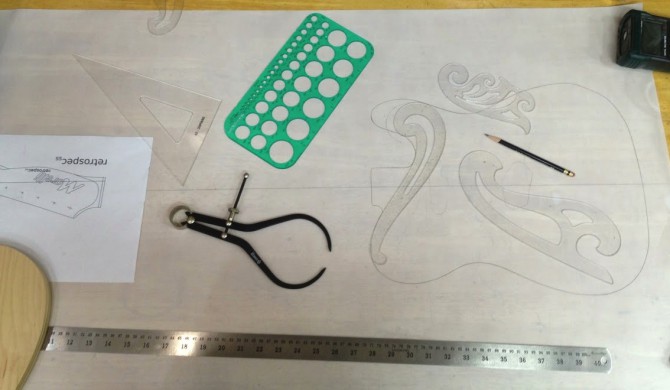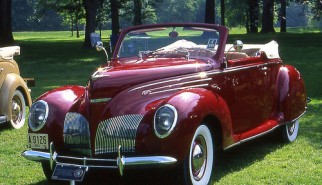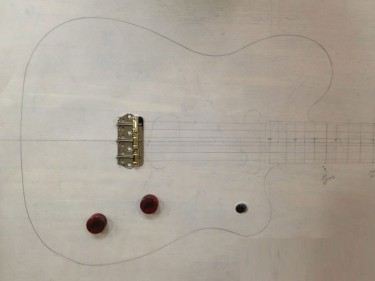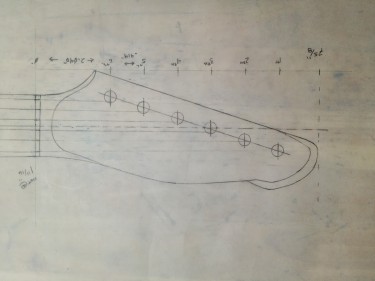
22
2013[The previous article can be found here: The retrospec – Introduction, Part 1]
I have always been a student of design, fascinated with how people create from their imagination. Having worked across a number of mediums over the years, I’ve enjoyed carrying inspiration from one discipline and applying it to another.
In the case of the retrospecss our goal was to bring forward the essence of the classic Fender® Telecaster®, accentuating its iconic aspects and removing those design elements which detract from the guitar. Obviously such an exercise is one of personal interpretation!

The French Connection – Coddington’s interpretation of the Lincoln Roadster.
The French Connection
I know of few people better at the game of reductionist design than hotrodder, Boyd Coddington. While customizing cars has been an American passion for sixty years, Boyd took the craft to a high artform.
Striving to create a crisp visual representation – accentuating lines, perfecting proportions, and shaving off parts such as door handles – Boyd’s cars always evoke a deep sense of style and beauty. His use of color was often minimal, accentuating the overall form in two colors or using one to allow the underlying shape to speak for itself.

1939 Lincoln Zephyr, as original as they came.
When we began working on our modern interpretation of the Telecaster, I immediately thought back 20 years to when I read Boyd’s (then new) books. I spent hours studying his designs and settled on Boyd’s last work before he passed away. Named the French Connection, Coddington’s creation was based on the 1939 Lincoln Zephyr as its inspiration.
Much like the Tele, the Lincoln Zephyr was a beautiful design, yet contained several stodgy elements. With smooth flowing lines, the Zephyr is nonetheless upright with broad step up rocker panels, an abrupt snout and period whitewall tires which detract from the essence of its shape. The bumpers and mirrors, while functional, are details which detract from the flowing shape.
Shaping the Body
Jumping right into the retrospecss there are a few basic elements that I wanted to address – the horn on the Tele looks bulbous – almost as if someone designed the cutaway with a hole saw. I reshaped the lower horn, creating a more gentle transition. Furthermore the shape of the body above and below the fretboard was re-curved to increase fretboard access while also creating a better visual line.

retrospecss body outline with mock hardware.
A few design elements are not evident in the drawing. The top of the body will be slightly carved with recurve, just enough to reflect light at different angles. The back of the body will have a tummy cut like the Stratocaster®.
Unlike the Tele, the body to neck transition will not be square but rather transition as a smooth curve. As a result the necks will not have a bolt-on plate but rather a 3 bolt system, freeing up the treble side of the body to be carved to meet the neck.
Finally several details on the body face depart from the classic Telecaster. Gone is the bulky “ashtray” bridge, replaced with a an elegant bobtail bridge. The chrome control plate is removed, the tone and volume staggered to follow the body line, and a 3 way toggle switch (with Tele switch tip) centered in the lower horn. Finally the bulky pickguard is removed and the pickups are rear mounted, with front routs just large enough for the pickup bodies to protrude.
The Headstock
Headstock designs always have a strong visual correlation to guitar makers. Fender electric headstocks, for example, mount tuners on one side and tend to have a similar (but varying) curvature on the treble side. There are many mediocre headstock designs (after all beauty is in the eye of the beholder). Designing an elegant headstock can be no small feat.

Headstock design maintains inline tuners with Starcaster flair.
The retrospecss headstock creates both a more elegant treble side shape and more consistent proportion from end to end. The headstock is also slightly longer and introduces a relieved tip that is reminiscent of the Starcaster. Finally a more unique transition from the fretboard to the headstock brings a more elegant transition versus Fender headstocks which have a simple swoop designed to be shaped on a cylindrical sander.
The next article will discuss the hardware choices and how they are mounted to the body. There are some unique design decisions which we’re excited to see come to life!

Drafting templates. Vellum. Digital calipers.
